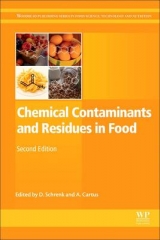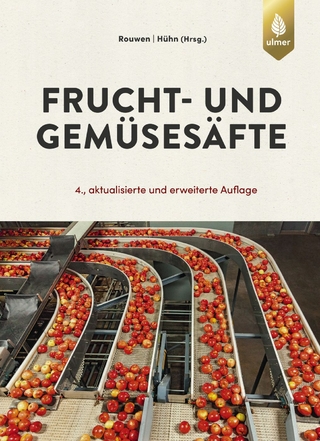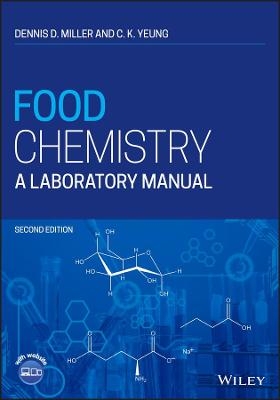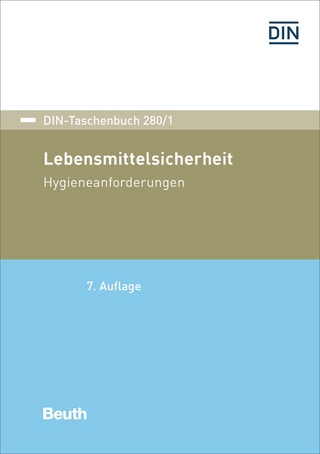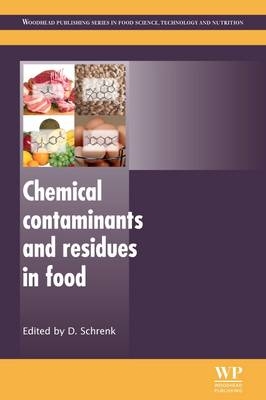
Chemical Contaminants and Residues in Food
Woodhead Publishing Ltd (Verlag)
978-0-85709-058-4 (ISBN)
- Titel erscheint in neuer Auflage
- Artikel merken
Chemical contaminants are a major concern for the food industry. Chemical contaminants and residues in food provides an essential guide to the main chemical contaminants, their health implications, the processes by which they contaminate food products, and methods for their detection and control.
Part one focuses on risk assessment and analytical methods. Gas chromatography and mass spectroscopy techniques for the detection of chemical contaminants and residues are discussed, as are applications of HPLC-MS techniques and cell-based bioassays. Major chemical contaminants are then discussed in part two, including dioxins and polychlorinated biphenyls, veterinary drug and pesticide residues, heat-generated and non-thermally-produced toxicants, D- and cross-linked amino acids, mycotoxins and phycotoxins, and plant-derived contaminants. Finally, part three goes on to explore the contamination of specific foods. Chemical contamination of cereals, red meat, poultry and eggs are explored, along with contamination of finfish and marine molluscs.
With its distinguished editor and international team of expert contributors, Chemical contaminants and residues in food is an invaluable tool for all industrial and academic researchers involved with food safety, from industry professionals responsible for producing safe food, to chemical analysts involved in testing the final products.
Professor Dieter Schrenk leads a research team at the Institute of Food Chemistry and Toxicology at the University of Kaiserslautern, Germany. Professor Schrenk has published extensively on a wide variety of topics within food science, with particular focus on health-related effects of food ingredients.
Contributor contact details
Woodhead Publishing Series in Food Science, Technology and Nutrition
Preface
Part I: Risk assessment and selected analytical methods
Chapter 1: Risk assessment of chemical contaminants and residues in food
Abstract:
1.1 Introduction
1.2 Risk assessment
1.3 Risk characterisation
1.4 Role of risk assessment in risk management
Chapter 2: Gas chromatography and mass spectroscopy techniques for the detection of chemical contaminants and residues in foods
Abstract:
2.1 Introduction
2.2 Gas chromatography injection techniques
2.3 Gas chromatography separation strategies 2.3.1 Conventional GC
2.4 Gas chromatography-mass spectrometry detection
2.5 Validation of new analytical methods
2.6 Applications and future trends
2.7 Acknowledgements
2.8 Sources of further information
Chapter 3: Applications of HPLC-MS techniques for the analysis of chemical contaminants and residues in food
Abstract:
3.1 Introduction
3.2 Ionisation techniques
3.3 Mass spectrometer systems
3.4 Screening and identification using HPLC-MS
3.5 Quantification using HPLC-MS
Chapter 4: Cell-based bioassays for the screening of chemical contaminants and residues in foods
Abstract:
4.1 Introduction
4.2 Description of bioassays
4.3 Transcriptomics fingerprinting technologies
4.4 Workflow of a transcriptomics fingerprinting-based screening strategy
4.5 Applications of transcriptomics fingerprinting for the screening of chemical contaminants and residues in foods
4.6 Conclusion and future trends
4.7 Acknowledgements
4.9 Appendix: Abbreviations
Part II: Major chemical contaminants of foods
Chapter 5: Dioxins and polychlorinated biphenyls in foods
Abstract:
5.1 Introduction
5.2 Properties and occurrence of polychlorinated dibenzo-p-dioxins and dibenzofurans (PCDD/Fs)
5.3 Toxicity of polychlorinated dibenzo-p-dioxins and dibenzofurans (PCDD/Fs)
5.4 Toxic effects of polychlorinated dibenzo-p-dioxins and dibenzofurans (PCDD/Fs) in humans and experimental animals
5.5 Properties and occurrence of polychlorinated biphenyls (PCBs)
5.6 Toxicity of polychlorinated biphenyls (PCBs)
Chapter 6: Emerging environmental organic contaminants in foods
Abstract:
6.1 Introduction
6.2 Polychlorinated naphthalenes (PCNs)
6.3 Brominated flame retardants (BFRs)
6.4 Polybrominated dibenzo-p-dioxins and furans (PBDD/Fs)
6.5 Mixed bromo-chloro dibenzo-p-dioxins and dibenzofurans (PXDD/Fs) and mixed bromo-chloro biphenyls (PXBs)
6.6 Perfluorooctane sulfonic acid (PFOS) and related substances
6.7 Conclusion
Chapter 7: Veterinary drug residues in foods
Abstract:
7.1 Introduction: risk assessment and risk management of veterinary drug residues
7.2 Major causes of the presence of drug residues
7.3 Group A – residues of substances which have an anabolic effect and unauthorised substances
7.4 Group B – residues of veterinary drugs: antibacterial substances
7.5 Residues of other veterinary drugs
7.6 Analytical methods for drug residue control
7.7 Residue monitoring programmes
Chapter 8: Pesticide residues in foods
Abstract:
8.1 Introduction
8.2 Regulation of pesticides in food
8.3 Pesticide residue monitoring
8.4 Risk assessment for pesticide residues in food
8.5 Special topics: organic and imported foods
Chapter 9: Heat-generated toxicants in foods: acrylamide, MCPD esters and furan
Abstract:
9.1 Introduction
9.2 Acrylamide in food
9.3 Monochloropropane-1,2-diol (MCPD) esters and related compounds
9.4 Furan in food
9.5 Future trends and conclusions
Chapter 10: Toxic metals and metalloids in foods
Abstract:
10.1 Introduction
10.2 Aluminium in foods
10.3 Arsenic in foods
10.4 Cadmium in foods
10.5 Copper in foods
10.6 Iron in foods
10.7 Lead in foods
10.8 Mercury in foods
10.9 Tin in foods
10.10 Zinc in foods
10.11 Risk assessment of toxic metals and metalloids in foods
Chapter 11: Toxicants in foods generated by non-thermal processes
Abstract:
11.1 Introduction
11.2 Ethyl carbamate
11.3 3-Monochloropropane-1,2-diol and glycidol
11.4 Biogenic amines in fermented food
11.5 Other examples of toxicants in foods
Chapter 12: D-Amino acids and cross-linked amino acids as food contaminants
Abstract:
12.1 Introduction
12.2 D -Amino acids in food
12.3 Digestibility and utilization of d-amino acids
12.4 Toxicokinetics and pharmacological and toxicological properties of individual d-amino acids
12.5 Cross-linked amino acids in food
12.6 Lysinoalanine contents in food
12.7 Nutrition and safety: digestibility, utilization and toxic properties of lysinoalanine and lanthionine
12.8 Conclusion
Chapter 13: Mycotoxins in foods
Abstract:
13.1 Introduction
13.2 Mycotoxigenic fungi and mycotoxin occurrence in foods
13.3 Toxicity of mycotoxins
13.4 Analytical methods for mycotoxins
13.5 Regulation of mycotoxins in foods
13.6 Future trends
Chapter 14: Phycotoxins and food safety
Abstract:
14.1 Introduction
14.2 Marine biotoxins
14.3 Application of LC-MS/MS methods for determination of assorted marine biotoxins in compliance with legislation
14.4 Cyanobacterial toxins
14.5 Application of LC-MS/MS methods for determination of assorted cyanobacterial toxins in compliance with legislation
14.6 Conclusion
Chapter 15: Plant-derived contaminants in food
Abstract:
15.1 Introduction
15.2 Pyrrolizidine alkaloids (PAs)
15.3 Ethyl carbamate
15.4 Tropane alkaloids (TAs)
15.5 Opium alkaloids
15.6 Grayanotoxins
15.7 Delta-9-tetrahydrocannabinol (THC)
15.8 Conclusion and future trends
15.10 Appendix: Abbreviations
Part III: Contamination of particular foods
Chapter 16: Chemical contamination of cereals
Abstract:
16.1 Introduction
16.2 Inherent toxicants
16.3 Mycotoxins
16.4 Heavy metals
16.5 Pesticides
16.6 Process toxicants
16.7 Food additives
16.8 Conclusion
16.9 Sources of further information and advice
Chapter 17: Chemical contamination of red meat
Abstract:
17.1 Introduction
17.2 Dioxins (polychlorinated dibenzo-p-dioxins and dibenzofurans, PCDD/Fs)
17.3 Polychlorinated biphenyls (PCBs)
17.4 Polybrominated diphenyl ethers (PBDEs)
17.5 Perfluorooctane sulfonate (PFOS) and perfluorooctanoic acid (PFOA)
17.6 Pesticides
17.7 Toxic metals
17.8 Veterinary drugs
17.9 Analytical methods for PCDD/Fs, PCBs, and PBDEs
17.10 Prevention and regulations of chemical contaminants in red meat
17.11 Conclusion
17.12 Acknowledgment
Chapter 18: Chemical contamination of poultry meat and eggs
Abstract:
18.1 Introduction
18.2 Unintentional exposure of poultry to chemical contaminants
18.3 Veterinary medicines as potential sources of residues in poultry products
18.4 Regulation of veterinary drugs in animal food products in the US
18.5 Future trends
18.6 Sources of further information and advice
Chapter 19: Contamination of finfish with persistent organic pollutants and metals
Abstract:
19.1 Introduction
19.2 Environmental contaminants in finfish and human exposure
19.3 Persistent organic pollutants (POPs) in finfish
19.4 Chlorinated pesticides
19.5 Polychlorinated biphenyls
19.6 Fluorinated compounds
19.7 Metals in feral finfish
19.8 Chemical contaminants in farmed finfish
Chapter 20: Contamination of marine molluscs with heavy metals
Abstract:
20.1 Introduction
20.2 Metals in marine bivalves
20.3 Metals in marine gastropods
20.4 Bioaccessibility of metals from shellfish consumption
20.5 Metal contamination in shellfish from particular areas
Appendix: Heat-generated toxicants in foods: heterocyclic aromatic amines
Index
| Reihe/Serie | Woodhead Publishing Series in Food Science, Technology and Nutrition |
|---|---|
| Verlagsort | Cambridge |
| Sprache | englisch |
| Maße | 156 x 234 mm |
| Gewicht | 1090 g |
| Themenwelt | Technik ► Lebensmitteltechnologie |
| ISBN-10 | 0-85709-058-5 / 0857090585 |
| ISBN-13 | 978-0-85709-058-4 / 9780857090584 |
| Zustand | Neuware |
| Haben Sie eine Frage zum Produkt? |
aus dem Bereich
